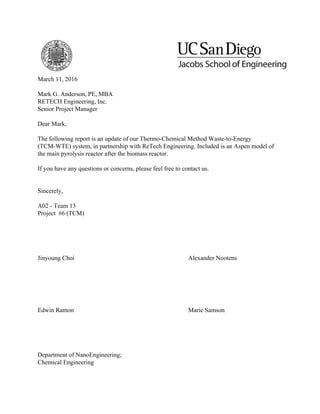Contenu connexe Similaire à ProgressReport3 Similaire à ProgressReport3 (20) 2. Introduction/Background
Thermo Chemical Method Waste to Energy (TCMWTE) system uses Municipal Solid
Waste (MSW) and converts it into energy from the syngas product. This feed should be able to
power a gas turbine or fuel cell to generate electricity. The inorganic components will be
converted into cast metals and gravel. The innovative portion of the this system compared to a
similar MSWtoenergy system is that it will lack an emission of hazardous gases, along with
inorganic secondhand solid, viscous or liquid waste and ash. In addition, TCMMSW to energy
will be using >90% of carbon dioxide onsite. The TCM system will be able to produce its own
electric and thermal energy needed for a continuous operation of the plant; therefore, no external
energy sources will be used. However, the total power generated through the system will create a
surplus of external power to provide to customers.
This TCMWTE system is to launch in Bristol, CT. The purpose of this system is to be
able to provide clean and safe energy through reduction of harmful gases. This technology will
be able to produce a positive impact on the environment. Another goal for this project is to create
a lower costing energy source, as low as $0.04/kWh, compared to electricity average retail price
in Connecticut of $0.155/kWh.
Similar waste to energy systems are in operation today. One such system is the
refusederived fuel (RDF) system used at the HPOWER facility on the Hawaiian island, Oahu. It
is a commercial plant that has been operating since 1990 and takes up to 3,000 tons of MSW to
generate up to 90 MW of energy, which is enough for about 8% of Oahu’s energy needs². In
Australia, Ozmotech developed a pyrolysis chamber that takes undesirable plastics and produces
over 19,000 liters of diesel fuel a day for less than $0.30 per liter³. The Department of Petroleum
4. kinetics required to run it were not available in currently available literature. The first reactor
operates at a temperature of 150°C, the second at 800°C, the third at 1300°C, and the fourth and
final reactor at 1600°C. Each zone provides specific products which are then fed to the next stage
in the reactor series. The third stage is mixed with the S+GREC which is comprised of the
recycled hot steam and syngas mixture that provides the main heating energy for the total overall
reactor. The final output stream is then deposited into a separator which will crudely separate the
syngas, metal, and slurry byproducts.
Figure 2: MSW input stream components represented as individual monomers
In Figure 2, the main plastics are modeled using vinylchloride, furion (the main
monomer of PET), styrene (the main monomer of PS), ethylene (the main monomer of HDPE),
and propylene (the main monomer of PP). Metal is typically a small component of MSW so only
a few of the most common components were used. Those used were aluminum, copper, and zinc,
respectively. A common monomer in many food products is butyricacid, which is typically in
many cheese and dairy products commonly found within the organic portion of MSW. In order
6. Mass Flow
Rate (ton/hr)
10 4.9 ~9.0 1.5 0.40
Table 2: Column Reactor Dimension [m] Plus Clearance
Total Required Clearance Height 18+5 m
Diameter Clearance
Base 1.8 m
Belt (@ 6 m) 2.4 m
Top (MSW Inlet) 1.2 m
Steam / Syngas Inlet 0.2032 m
Steam / Syngas Outlet 0.2032 m
Future Work/Plan of Action
At the halfway mark of the project, there is still much to be done. Calculations for
optimizing the recycle stream and the reboiler are underway to maximize the produced energy.
Plans to convert the produced chemical energy of the reactor to electrical energy will be done
with a fuel cell. The fuel cell used is FuelCell Energy’s 2.8 MW DFC3000 system. There will be
five of these fuel cells stacked in series in order to produce up to 15MW. The fuel cell has high
efficiency and low environmental impact perfect for the desired design. The Aspen model is still
being designed to accurately accept the different components of MSW that the pyrolysis reactor
will be fed. In addition, we are researching the components of MSW that is specific to Bristol,
CT.
7. Selfteaching of COMSOL Multiphysics Simulation Software is ongoing as COMSOL
will be used to model the reactor and optimize the design solutions. Specifically, learning how to
model the decomposition of the MSW is occurring. With COMSOL, the major and
noncommercial components of the reactor can be modeled.
After designing and simulating our prototype through Aspen and COMSOL, an
economic, environmental and safety evaluation will need to be done. The economic evaluation
will have a comparative economic analysis and economic comparison between different virtual
systems. Research will be done to look up the environmental and economic impact the system
will have once built, as an environmentally safe and overall profitable system is desired. In
addition, Connecticut's regulation codes and permitting requirements for the system needs to be
found, as plans are set to have this system built in Bristol, CT.
References
[1] Bajus, Martin. "Thermal Cracking of Mixtures of Plastics and Woody Material." Petroleum
& Coal53.1 (2011): 17. VÚRUP, A.s. VÚRUP, A.s, 1 Feb. 2011. Web.
[2] "EnergyfromWaste Facility." Covanta. Covanta, n.d. Web. 9 Mar. 2016.
[3] Smith, Melanie. "Recycling and Pyrolysis of Plastic." Whole Systems Foundation. Whole
Systems Foundation, n.d. Web. 9 Mar. 2016.
